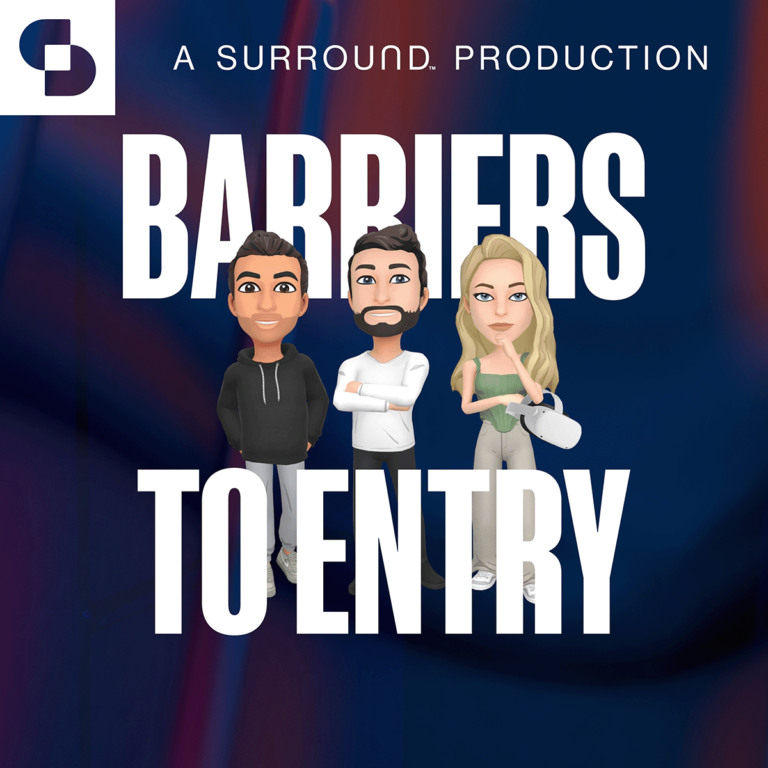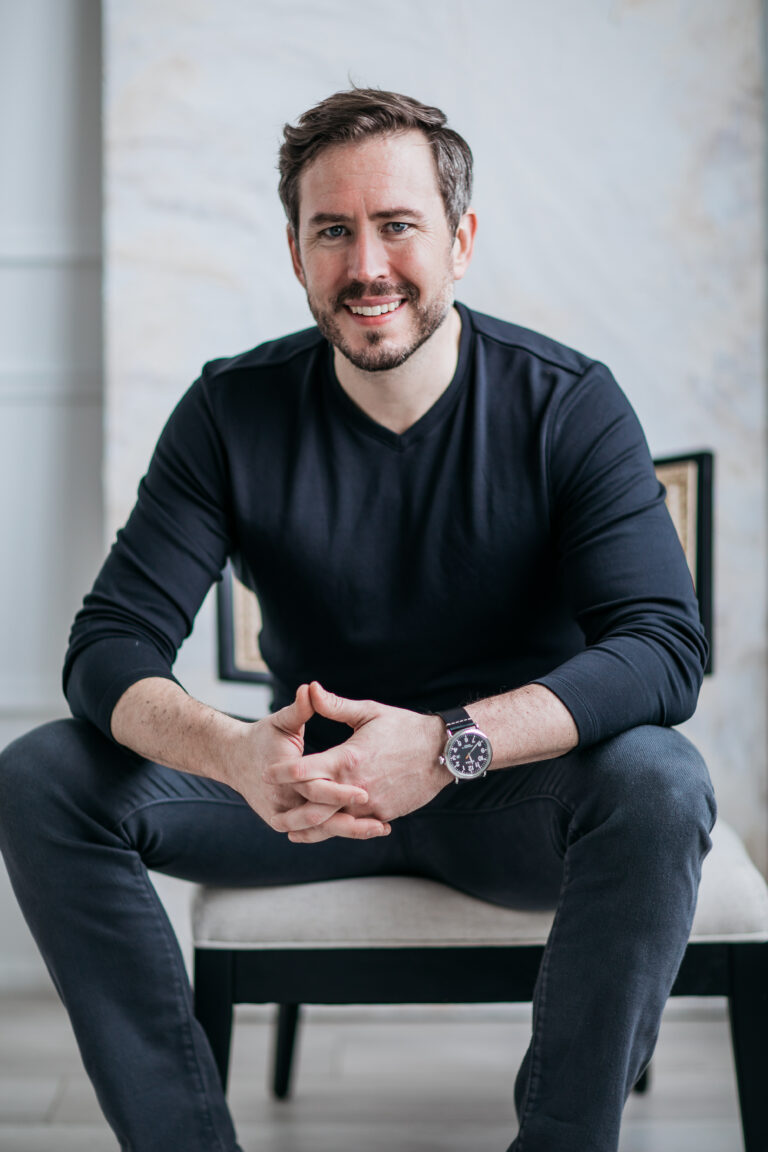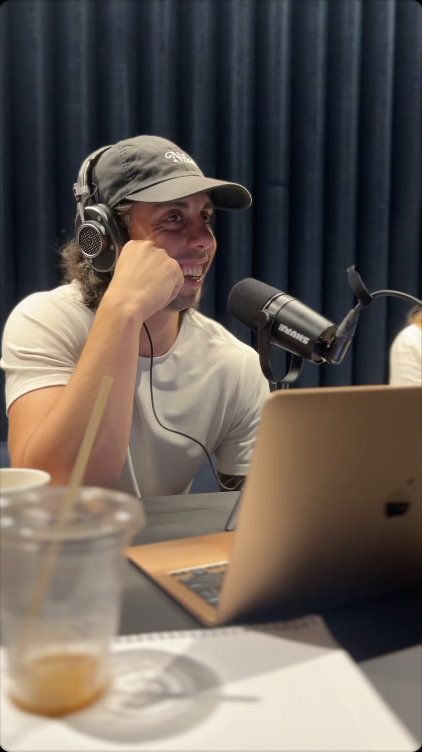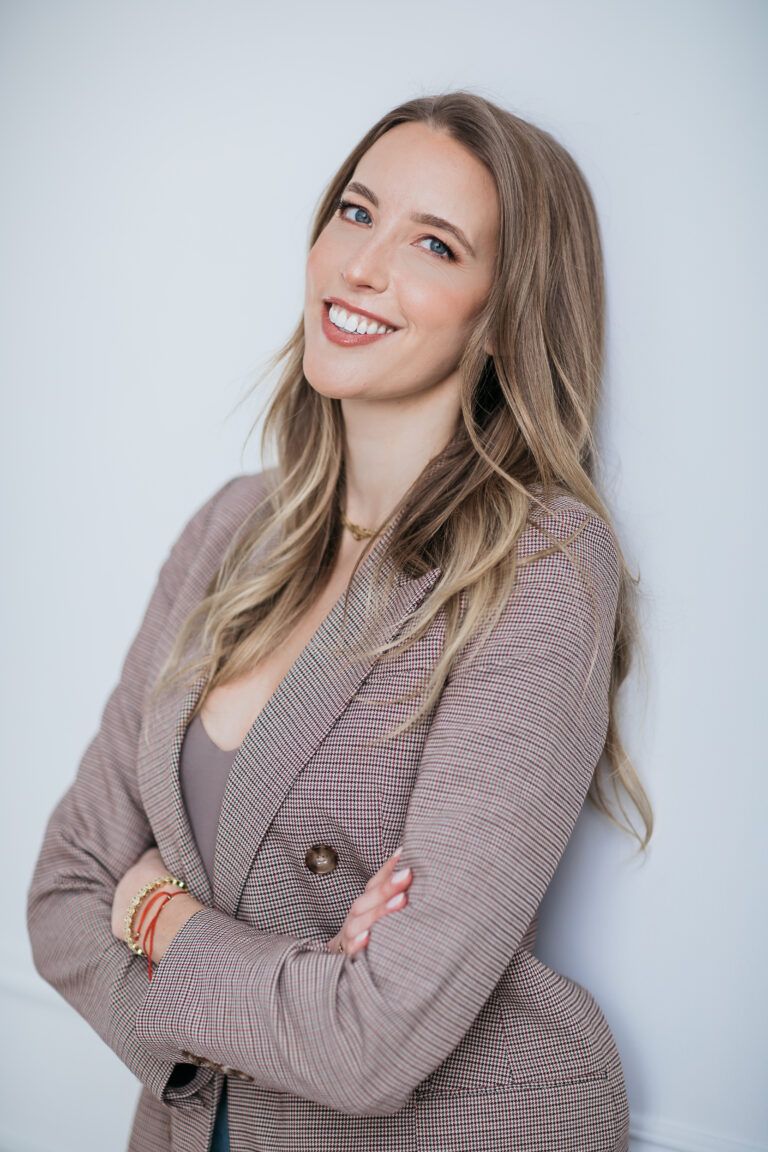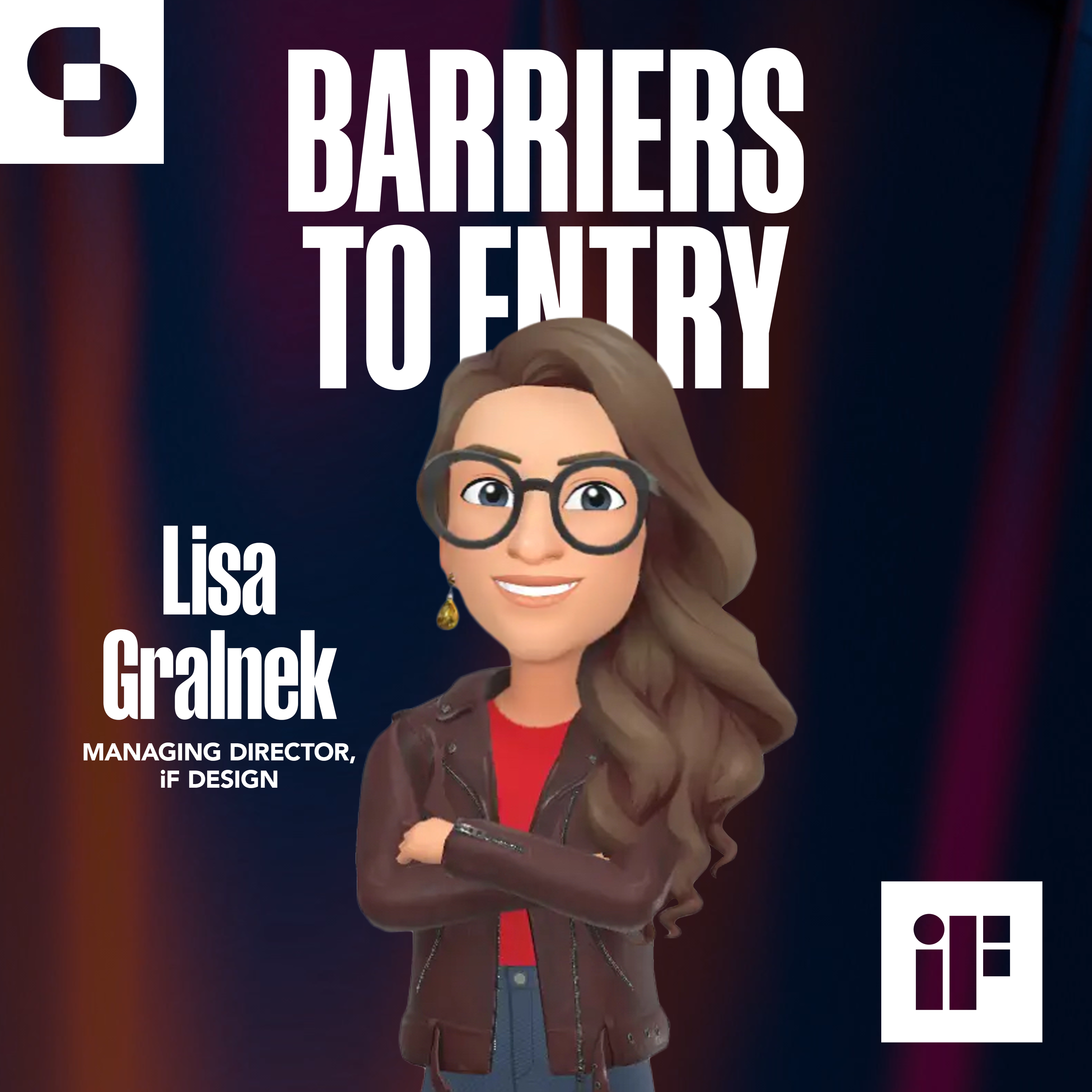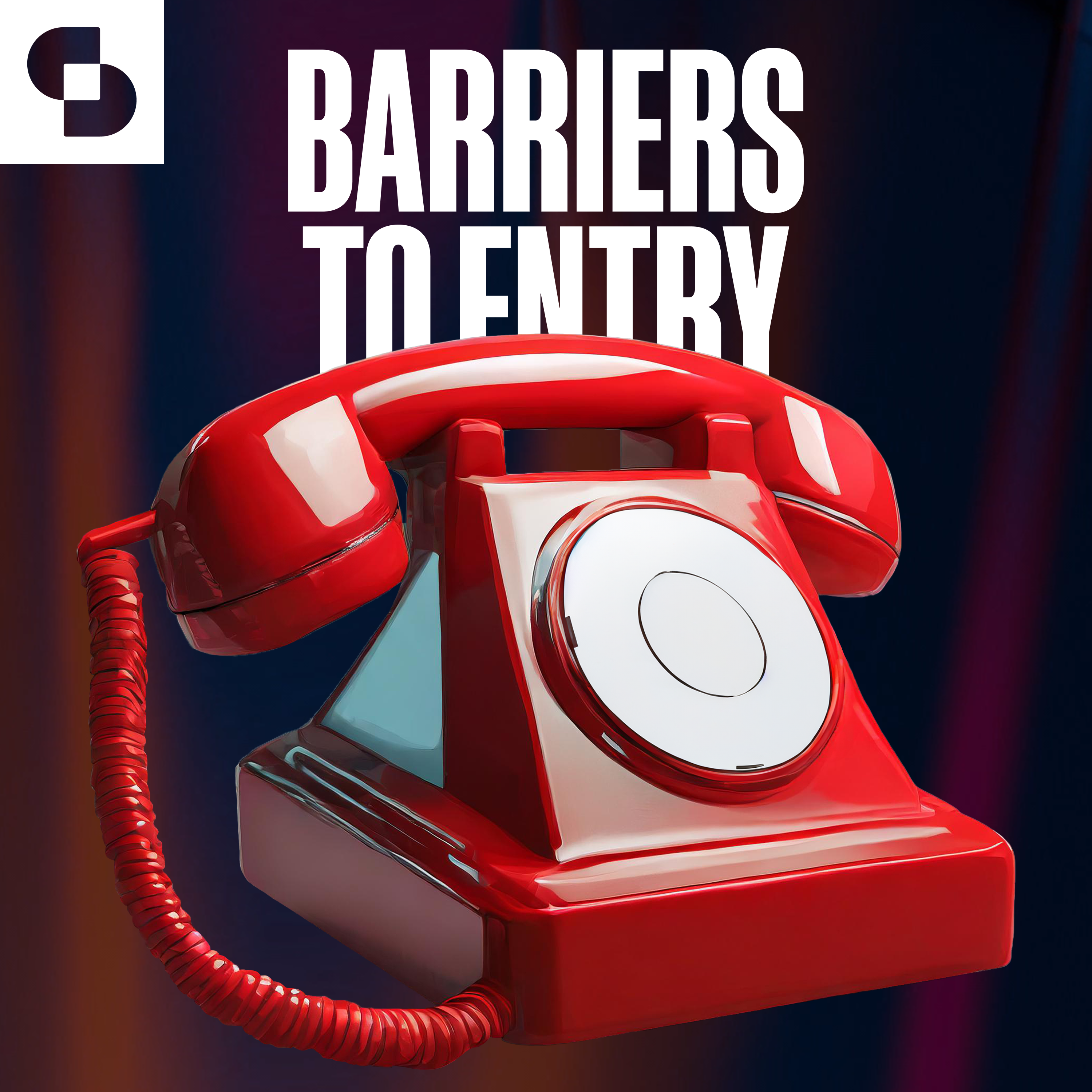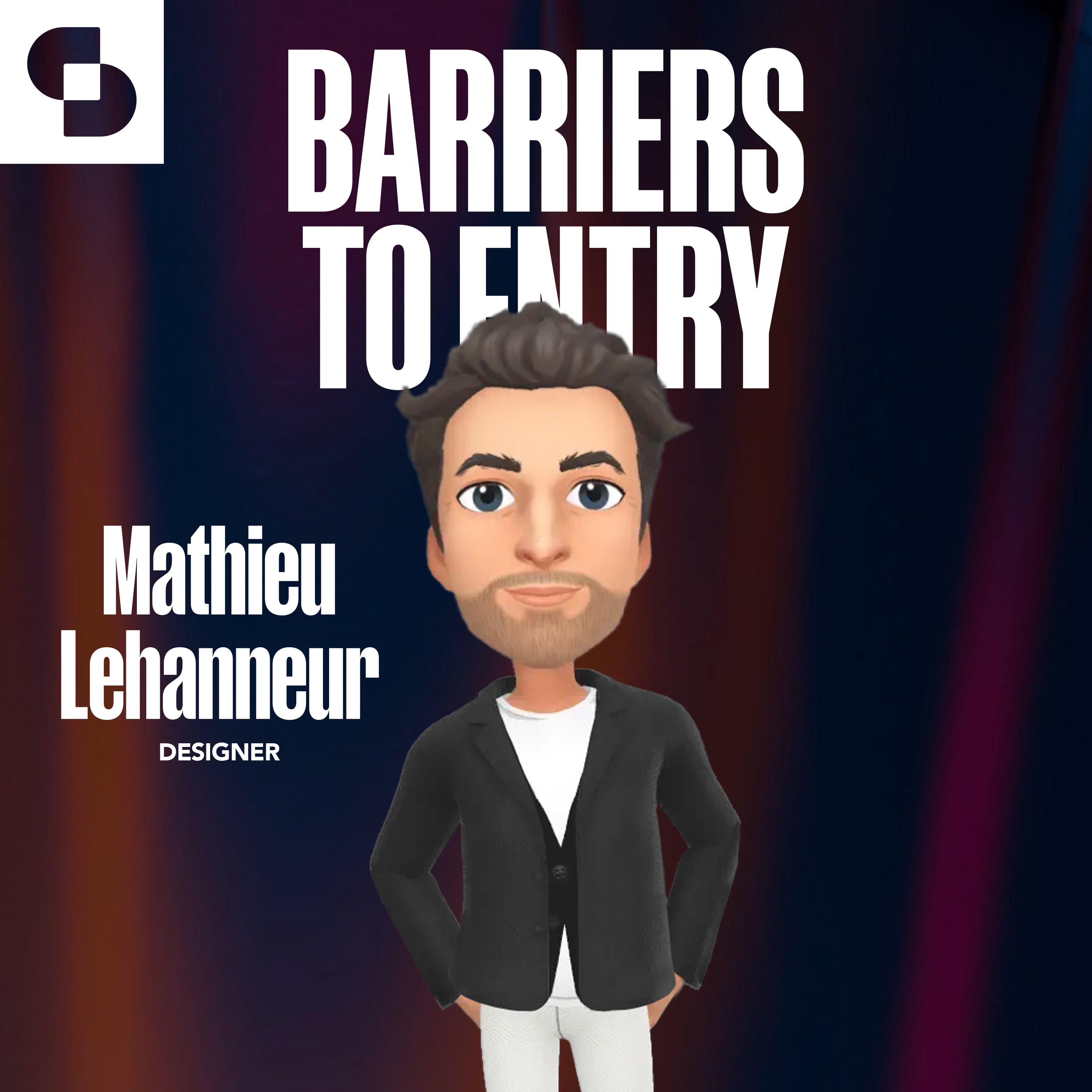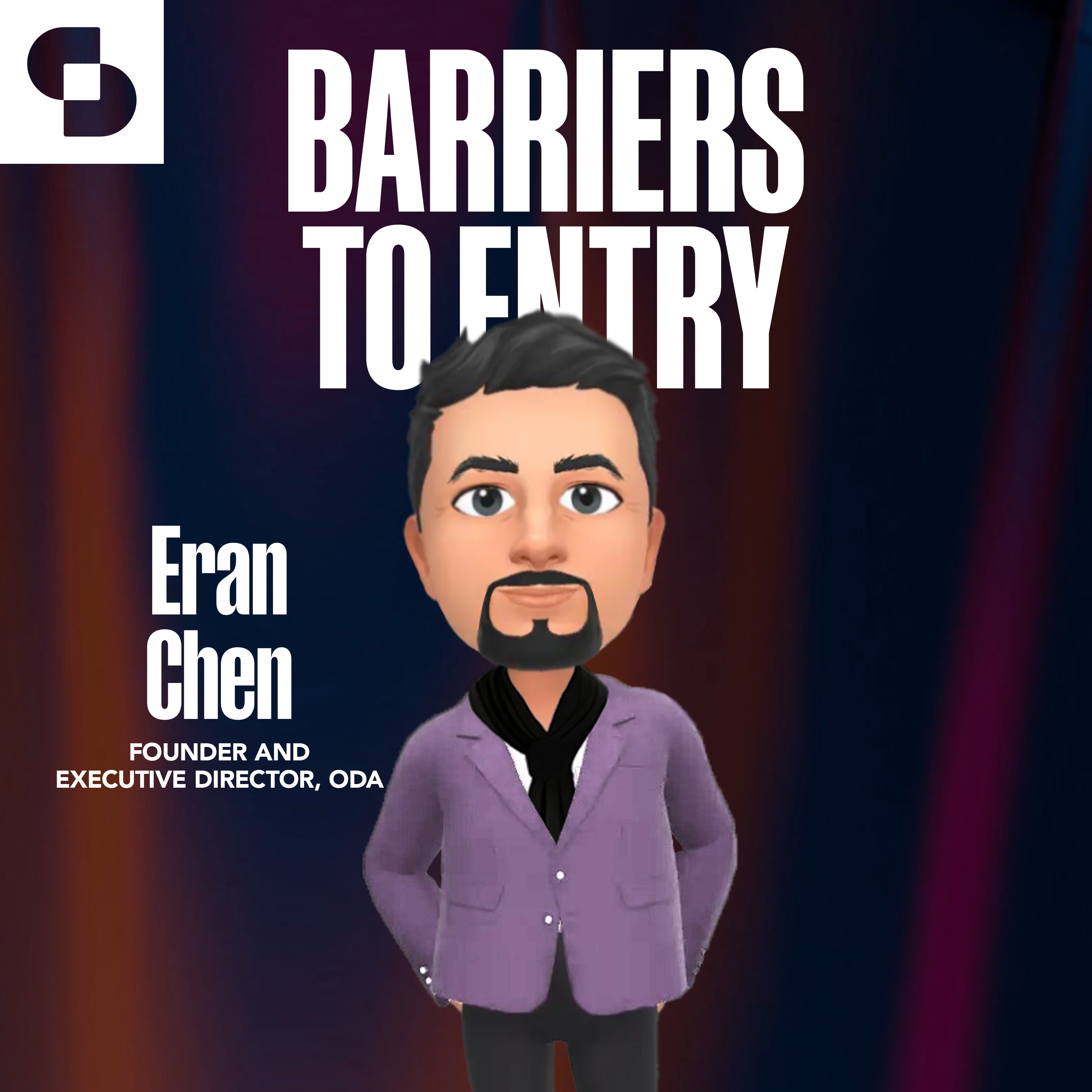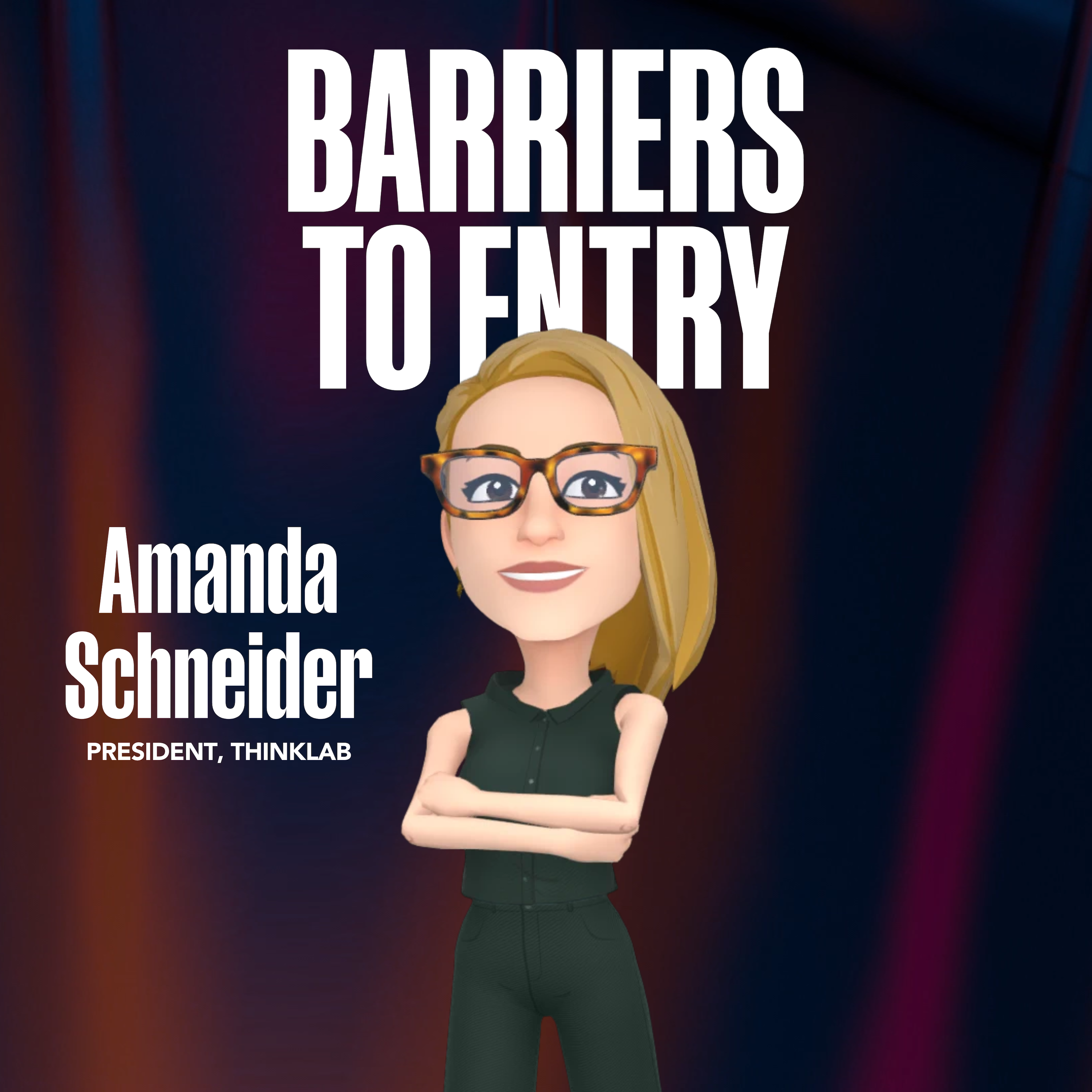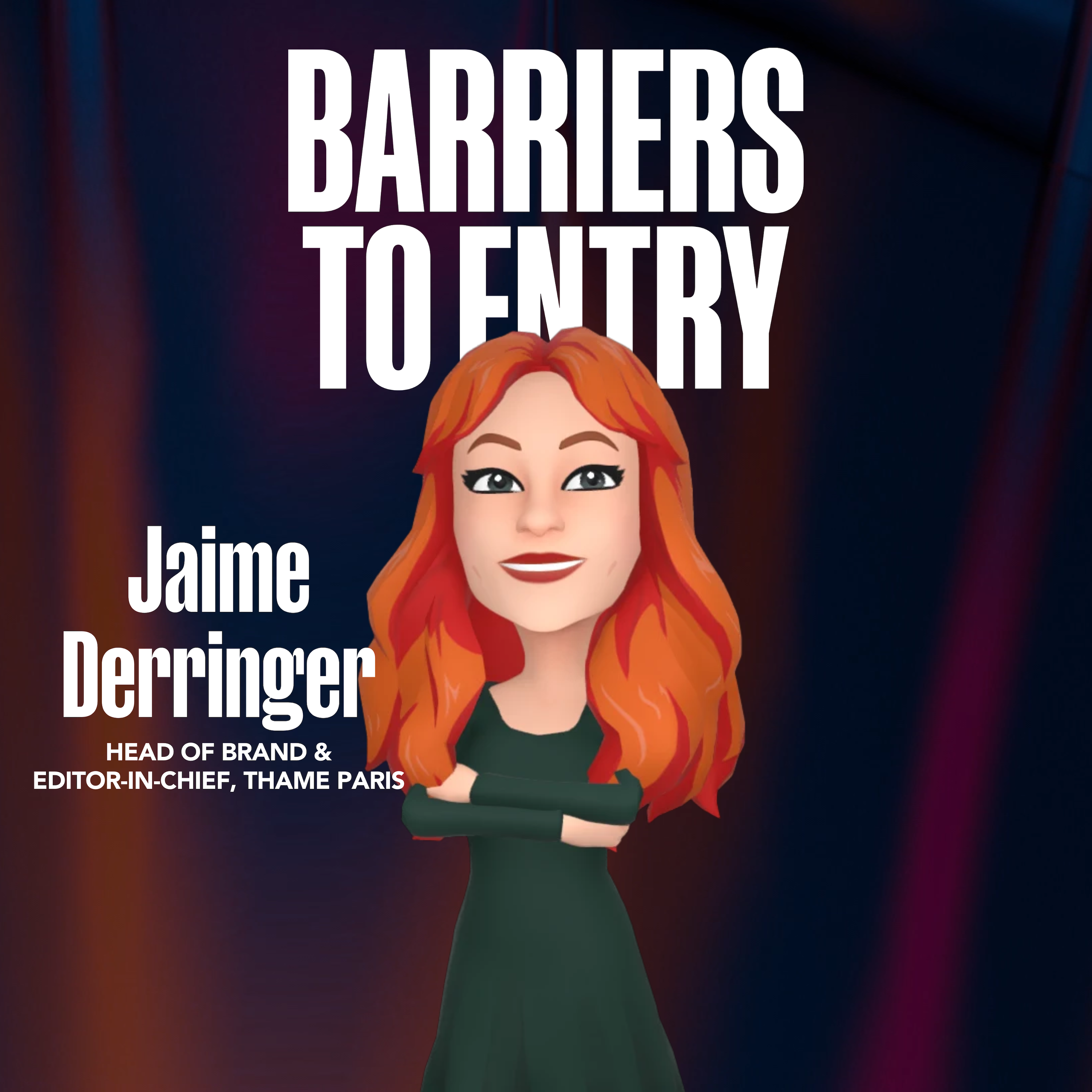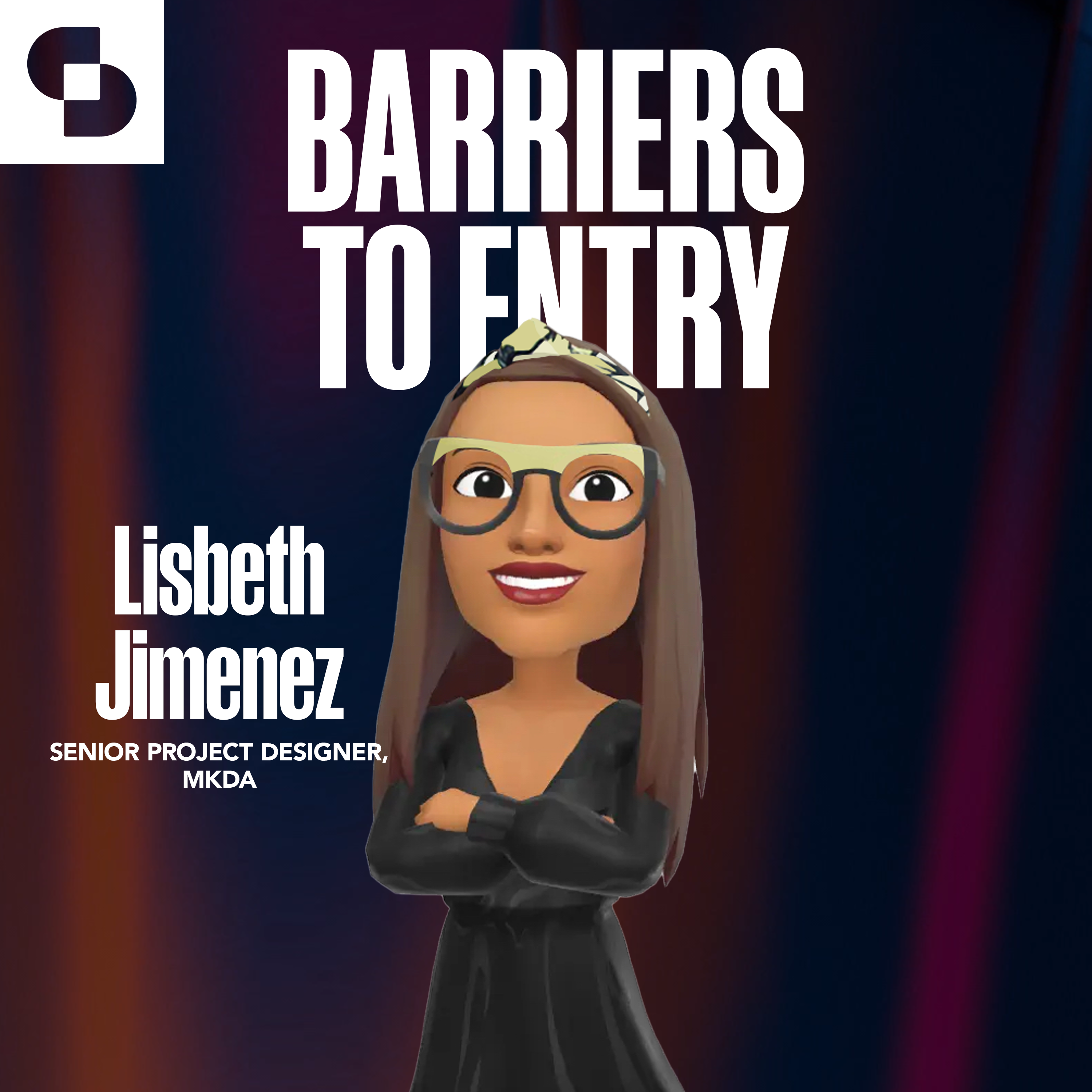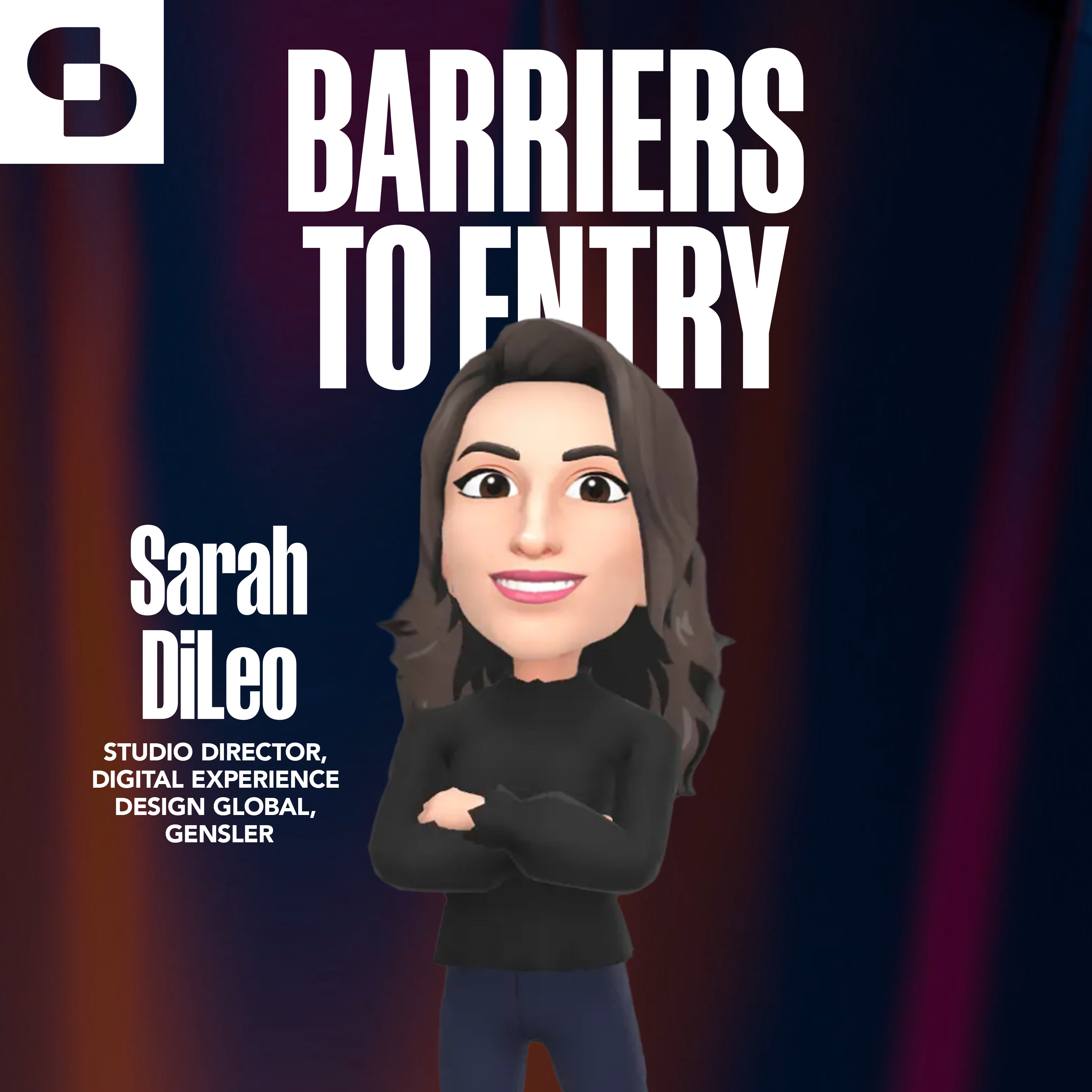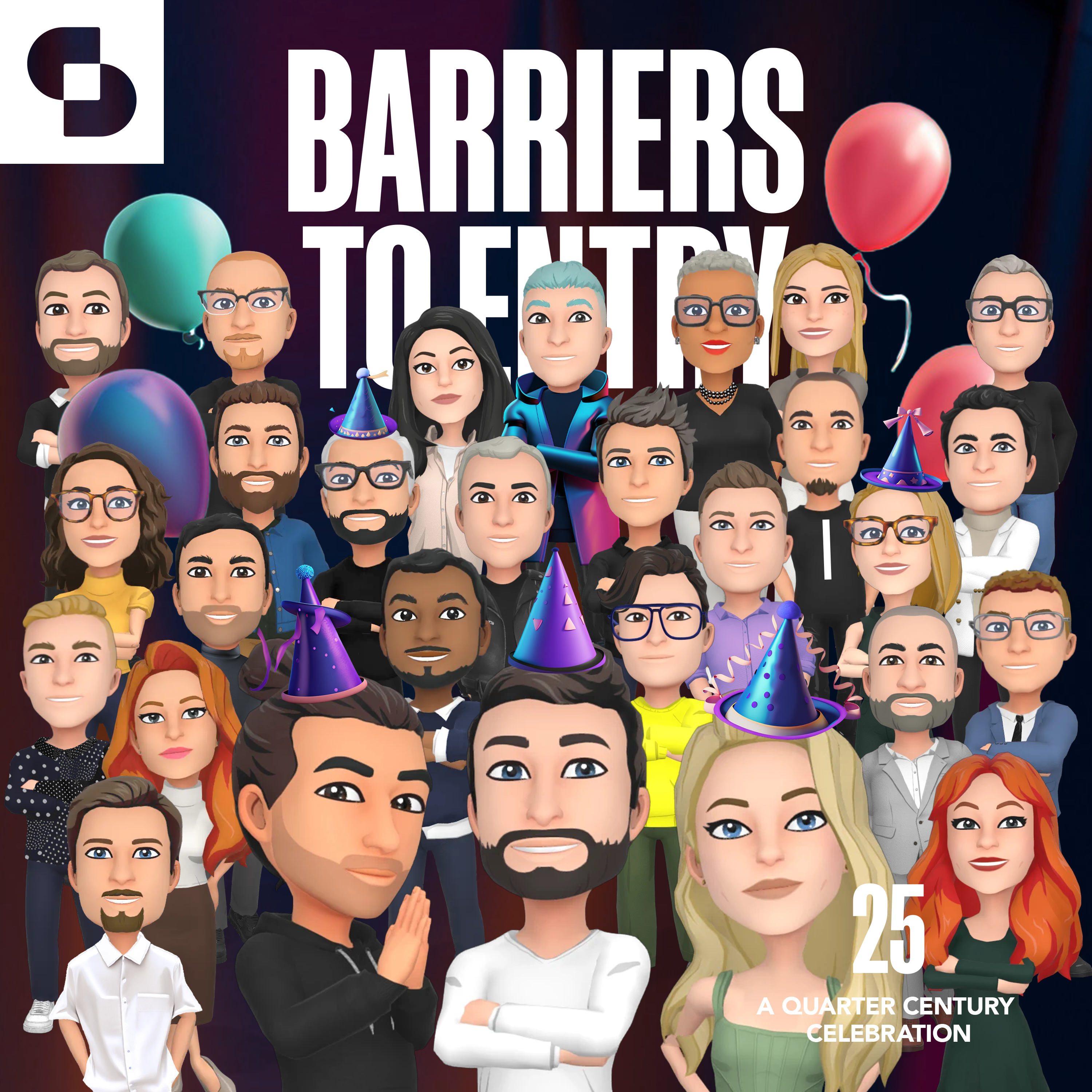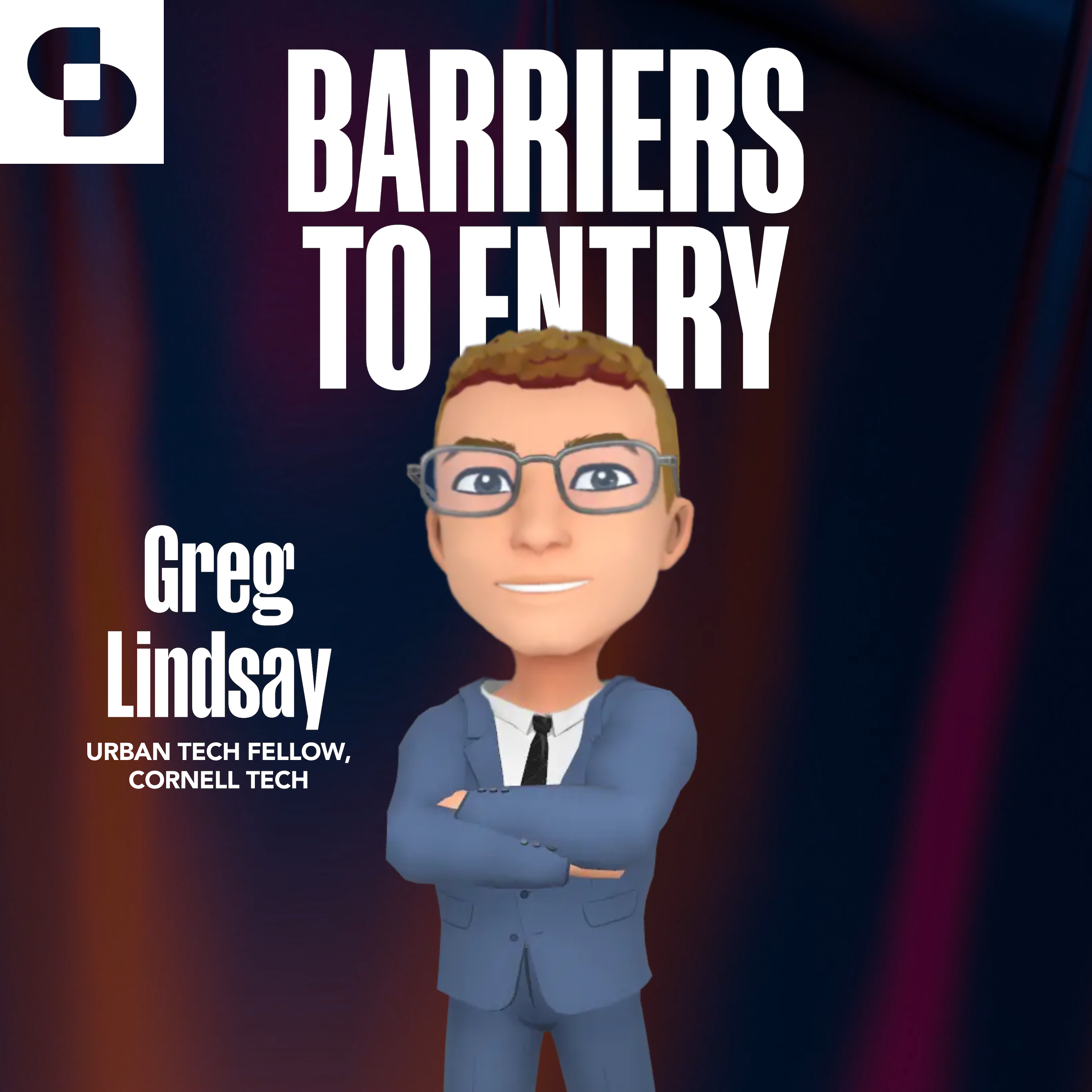Love is in the air on the pod as the gang celebrates Valentine’s Day and spreads the love by welcoming SVP of Product and recently-appointed Head of Metaverse, at Crate & Barrel, Sebastian Brauer. Bringing together experiences from the worlds of both design and technology, the discussion ranges from the experience of being first to market, the approach Crate & Barrel is taking to learn before they leap, the power of data in design, and more. You’ll love yourself for giving this inspiring conversation a listen.
Connect with Sebastian Brauer on LinkedIn!
Moments to check out:
- Sebastian’s “gateway” into exploring Web3 (starts at 9:04)
- Advocating for web3 inside an organization (starts at 18:38)
- How to navigate being first in a new space (starts at 30:38)
- Data as a core design principle (starts at 39:33)
Connect with our hosts on LinkedIn;
References and resources:
- Bill Gates / David Letterman internet video (mentioned at 34:39)
- Matthew Ball’s The Metaverse: And How It Will Revolutionize Everything)
- Neal Stevenson (Snowcrash + Lamina1)
- Web3 tools to get started;
- Discord
- ChatGPT
- Dall-E
- Midjourney
- Linkedin (of course)
- Interconnected Realities book
Discover more shows from SURROUND at surroundpodcasts.com. This episode of Barriers to Entry was produced and edited by SANDOW Design Group. Special thanks to the podcast production team: Hannah Viti, Wize Grazette, Kasey Campbell and Samantha Sager.
Sebastian Brauer: [00:00:00] Being data driven and gathering insights, not only, on the micro level, but at the macro level, should really be what informs good design,
Bobby Bonett: Love is in the air, and I’m excited to welcome everybody to the latest, the newest episode of Barriers to Entry, the podcast where we explore the intersection of Web3, the Metaverse, digital universes, the blockchain, and a whole bunch of other buzzwords with the architecture and design industry. I’m Bobby Bonett.
I’m here with my two favorite co-hosts, Andrew Lane and Tess Bane. If and if I may, you. Let me be the first to wish you a happy Valentine’s Day.
Andrew Lane: Wow.
Tess Bain: that’s really sweet.
Andrew Lane: That was, one of our most romantic intros as well. I also feel badly for anyone else who co-hosts anything with you. That’s not us, cuz they’ve definitely been put in their rank. Yeah.
Bobby Bonett: I was asked, by my oldest daughter, a couple weeks ago. . Moms and dads aren’t supposed to pick favorite kids, right? And I said [00:01:00] Yes. And she said, well, If you’re pretending who your favorite kid is, who would that favorite kid be? But, I did not give her an answer, but I’m happy, to call both of you my co favorites, um,
Tess Bain: I think I’d want you to pick, not to put you on the spot, but
Bobby Bonett: Well, let’s revisit this in the outro today. Andrew, why don’t you tell us a little bit about, our guest and, uh, and what you’re looking forward.
Andrew Lane: I would be delighted cuz I was very excited, when I learned that Sebastian Brower was going to be joining us. Sebastian, made some news in our little corner of the industry a little while back when he was named, the Chief Metaverse Officer, at Crate & Barrel. So obviously a major and prominent force in the industry.
Naming a really, important title, on top of his role in product. So I think that’s also really telling, and I think, it’s really gonna come through in the conversation that we’ll have is that he’s someone who comes from a background of design and product, but he’s, been compelled by technology and, sort of learned and earned his way into, I think, a really unique role. so, really excited to have him.
Bobby Bonett: Learned and earned is the next, t-shirt [00:02:00] that we need to produce, but it’s also, on the money. You’ll hear Sebastian, I don’t know how he fits the amount of research and reading he does. Into his day. But he’s a wealth of resources and, and I’m gonna be excited that we’re able to share those with you.
Tess Bain: And kudos to Crate & Barrel too, just for being, insightful enough to recognize the importance of having someone like him investigating this space. The way that he is so thoughtful about his approach and, as an organization. I mean, you spoke about the amount of research and time he spends, but that’s, I think, going to be one of the most exciting things to see is what they finally, move forward with when they do launch.
Andrew Lane: I think that’s a really good intro. let’s get to Sebastian and see what all he has to share with us.
Bobby Bonett: Here today on Barriers to Entry, we’re psyched to have one of our industry’s premiere Web3 thought leaders. He holds the illustrious title of Head of Metaverse and Web3 at Crate & Barrel, and is also the company’s Senior Vice president in charge of product design and development.
Welcome to the pod Sebastian Brauer.
Andrew Lane: Welcome.
Sebastian Brauer: Thank you so much for having [00:03:00] me here. I’m delighted to be.
Bobby Bonett: we’re delighted to have you we did want to start off today, just by asking, you to tell us a little bit about your first iPod.
Sebastian Brauer: Oh, you’re asking me to travel way back in time but, lots of good memories associated to that. I always loved music. I remember going to the mall and buying CDs back in the day, right, and playing them in my, little boombox, which was awesome. So when the first iPod came out, I was just mesmerized and I remember it being the first version.
Actually, I was very, very lucky that, my uncle actually got his hands on it. I grew up in Ecuador and it wasn’t the easiest thing to get your hands on technology. So I’m sure he bought it in the States during a trip or something and it was white, and it had a sort of more analog kind of wheel that would make that sound and it could only hold, I think 150 songs. The first version, if I’m not mistaken. But it kinda like, changed, my life and my view of technology. I completely skipped the whole mini disk, situation.
Sebastian Brauer: And I went straight from CDs to the iPod and it was [00:04:00] such a fascinating jump to me. And that’s where. My head really started to sort of respect, admire, and just be very interested in technology.
Andrew Lane: So just personal curiosity, you never made mix tapes then You, skipped that part of the, generation
Sebastian Brauer: Maybe a little bit, maybe a little bit. it was when you had that good song in the radio that you would have to wait and kind of just be sitting by it to catch it. I would do a little bit of that. Yeah. Yeah.
Andrew Lane: I was a big, mixtape guy back in the day, but I always remember the first iPod for the advertising too, because it was such a, a moment where they not only made something that made so much sense as technology, but also they made it so accessible to the consumer, by the way, that they just, they made it instantly cool.
you’re right. The advertising campaigns as anything that Apple does were absolutely brilliant. I remember also like the black outlines of people kind of like holding it and dancing to the music, they were super aspirational and just ultra cool.
Tessa Bain: I just love that little like click, click, click, click, click when you like, do the analog scroll.
Sebastian Brauer: I remember that. Yeah. [00:05:00] Yeah. Now we have iPhones that don’t even have a wheel, right? A button. It’s all touchscreen.
Bobby Bonett: I’m wondering, Sebastian, when you talk about, your first iPod, You’re recalling, the mesmerization that you had, not only about the product and the technology and of itself, but that design angle, in Apple, obviously notorious for its design.
Did you find that, from a young age that you had a, a passion for both technology and design? And then how did that start to dovetail, as you started, making your way towards school? and ultimately manifest itself in, in the career that you’ve carved out for yourself, over the past, couple of decades.
Sebastian Brauer: Yeah, I, I do, and I think what struck me the most was how it solved. A huge problem. Right. it made music portable. it brought music to where you were, it made data portable. Which is sort of what unlocked the way that we interact with computing today, where we don’t have to sit on a desk, we don’t have to be on a desktop.
It’s with us 24 7 and it’s absolutely portable. And it was that notion of solving problems and how design is at the center of that, that sort of drove me to know at a very early age that I wanted to be a [00:06:00] designer. Pair that with the fact that my mother was an architect. My family… one part of my family was always in the arts, and I grew up around art and I grew up around architecture and I grew up, being educated about it from my mother.
So, combining architecture, design, problem solving technology. the arts, to me, very early on, I knew it was my passion and, and something that I wanted to pursue. So even in high school I was very deeply immersed in design, just reading about it, learning about it, going to exhibitions that I was drawn to, and, I knew, that I wanted to study industrial design very early on, and I just was very clear on that and it, took me on my path that I’m in today.
Andrew Lane: So do you think that all these influences have given you a bit of a, a different approach, to product design than you would say is typical in architecture and design industry? Or how do you, think about your approach?
Sebastian Brauer: I would say so I would say that my approach is first collaborative, it’s data driven. It’s driven by customer insight. It’s driven by, macro data, right? To understand [00:07:00] what’s happening culturally, what’s of relevance, what problems are we facing, what challenges are ahead of us. I’ve kind of moved away from the form and function type of approach that we’ve heard for, for so many years.
That’s, that’s sort of a core principle. and moved into a more tech-driven, solution-oriented approach that factors in far more than just the beauty of something and consider sustainability, portability, usability, and the human factor at the center. So I would say that my approach is certainly leveraging technology and applying it to everything that we do, but in a way that you also use your, human thinking to create value.
Andrew Lane: I love that. I’m just curious, for people out there who are thinking in that way, I think that it’s definitely a rising cohort. How is it that you made that a compelling conversation for the organizations that you worked in to take an approach that really looked at technology and data to lead?
Sebastian Brauer: Well, through action, right through [00:08:00] testing and failing to prototyping, taking risks, being courageous, but mostly by showing that design is a transformational tool. The design can transform. And it’s not only about product, but it’s also about the way of working, how organizations come together, how you look at the entirety of organization and you look at the work and how the work is being done, grounding it with purpose.
So it’s been a lot about bringing people together and blurring the line from design, just being about product and also being about experiences, interaction. education, the spiritual and psychological, I see design as a practice that really can envelope the entire being and it can impact so many different practices.
Design thinking and creative thinking can be applied to finance, to operations, to engineering. It really is that through line Of harnessing the best of the brain and applying it in in different mediums.
Tessa Bain: that’s a really [00:09:00] good segue we really want to hear how you got curious about Web3. I mean, maybe it was the process of using that design thinking, what was the route or the initial interest in web3 for you?
Sebastian Brauer: Yeah, I would say that cryptocurrency was a gateway, but not necessarily the financial asset trading piece of it, but the principles of decentralization and what that meant. That really pulled me into web3 first. Right, and just the idea Of how we look at data, how we can leverage blockchain technology for authentication and personalization, but also for decentralization and for us to really be true owners of our data with true transparency.
and what that meant, sort of like understanding the, power of blockchain technology and how it can be the first layer, to activate Sort of a different socioeconomic system, a completely new paradigm, right? so that was my gateway. I started to dabble a little bit in NFTs in the middle of that nft hype craze when NFTs achieved some crazy valuations.
I got [00:10:00] lucky with, a couple of them. and now we’ve o obviously seen the market kind of change and people start to really question value, but I was really drawn into the collectible, aspect of it, and mostly more so than the art value of what I was acquiring. I just wanted to understand what that journey meant. how you could purchase one, how you could trade with it. what culture and community around it was deeming something so valuable. That was my draw. And then of course, as I started to learn more about it, I started to learn more about the metaverse, which It’s important to note that the metaverse and Web 3.0 are completely different concepts.
and yes, they have overlap, right? But conflating both is part of why, people are confused when you speak about
Andrew Lane: it’s kind of how we have a podcast, Sebastian, so thanks for calling that out. That’s a, that’s a headline for us,
Sebastian Brauer: Yeah. So I would say Web3 was my gateway that unlocked the metaverse, and then I started to connect with Metaverse thought leaders. I have a lot of people in this community that I’ve started to connect and reach out to that I’m learning a lot from.
[00:11:00] One of them is Kathy Hackle. I was definitely drawn into Matthew Ball’s, thought leadership, and devoured his book, the Metaverse and how it will change everything when it came out. obviously Red Neil Stevenson’s novel Snow Crash. I have tremendous admiration for him and what he’s doing now, particularly his company, lamina one,
And then the metaverse, from web3, my thinking started to really go deeper into the metaverse and seeing this , as a new dimension, For a designer and for an artist to feel that an entirely new world has been unlocked and an entire new medium to create that is not bound by physical constraints.
It’s just to me, A gift. A gift, that is packed with optimism, that is packed with possibilities and a gift from pioneers in, gaming, media futurists that have written about it in novels and in films. And, I would say that my mind is, between both worlds, And understanding what’s happening in both areas.
Right now, you’re seeing a lot of artificial intelligence coming into center stage, which is another technology [00:12:00] that is part of what the Metaverse can be. . Um, and we’re in the very early days of this, right? I was listening to Chris Cox and Neil Stevenson actually at the World Economic Forum talking about the importance of having an open metaverse and building it from the bottoms up and the importance of it being decentralized and, it belonging to citizens and, how we’re in the very early days of this, I think Chris Cox called it the Xerox Spark days, which was the early days of the mouse.
You know, we’re just at the tip of the iceberg. What I do know is that there’s a lot of businesses and tech businesses and startups building a lot and creating a lot, and that’s what’s underwater right now. So what’s upon us in the next decade is absolutely fascinating and, and incredibly encouraging.
And as a designer, that’s always thinking about the future. it couldn’t be more exciting.
Andrew Lane: So how are you thinking about your first steps? Like that was a really big vision that you just laid out, and I’m sure that there’s a listener or two who’s breathing into a bit of a paper bag right now, [00:13:00] digesting all of that breaking this down. you’re a data oriented guy.
You do things methodically. How do we get started?
Sebastian Brauer: Well first set some really good values for yourself, values for which you wanna go by that, that you wanna build with. To me, it’s all about building and creating with intention, and drowning the hype. There’s been so much hype around this, to really set a philosophy and understand this, it has to start with education.
You have to be purpose driven and you have to build with intention. I think that a new world is being built right before our eyes, and that’s inevitable. And we’re being gifted a massive blank canvas. A canvas that is not flat, but also a canvas that says, handle with care. This is the fourth dimension, and in my eyes, a transformational discovery of our time and. it needs to be treated as such. It needs to be treated with respect. You need to be educated. Needless to say, you, you need to have fun with it as well. you need to try, experiment, fail. but also you have to be very thoughtful. So, as a [00:14:00] leader within a brand, the way that we’re working is, is with that set of guiding principles, intention, quality, beauty, experimentation, emotion connection. And we’re not rushing into things. we could have easily said, okay, we’re launching a collection of NFTs that will unlock some sort of loyalty program for you and some sort of physical activations. We haven’t done that. We, we don’t see true value in that yet. Right now we’re sort of studying, connecting with the community that’s, that’s creating exciting things in this space.
and learning together as an organization. Yes. The Metaverse and Web3 has fascinating applications to the customer, to the consumer. Amazing at consumer facing applications with tremendous potential. But there’s also. A lot that it can do inside organizations and apply to so many working functions.
You look at legal, you look at intellectual property, you look at finance, operations, customer service, product [00:15:00] design, right? And how you’re leveraging 3D tools to build. Digitally first and then physical, right? So we’re spending a lot of time learning together, learning together as a group, almost like a think tank, just because this is not a task for one person to undertake.
we see that the more minds that are in it from all different areas of the business, even architecture, store design, visual merchandising, that are bringing ideas to the table, being deep, deep in their world and, contextualizing what all of this can do to their day-to-day is been a really great way to get started.
So we have no rush to launch something. Yes. I’m working on a series of different things, I would say at, at an exploratory phase right now. And that will lead to something when we’re ready to introduce it to the world, we will, but we want it to be accessible. We want it to be. Human-centric,
We want it to be about the experience. We see the metaverse as a space for gathering, whether that’s educational, whether that’s emotional, spiritual, psychological, all of the good [00:16:00] things that design can do in the physical domain, in its analog form. We wanna bring that back to the digital domain. So we’re being very intentional and being very careful about what we launch, and that it, it needs to be interoperable.
It ha it needs to have utility, it needs to be inspir. And it needs to be easily digestible.
Tessa Bain: I like that you could call me curious or you could say nosy. But, when it comes to mass market adoption, the things that major corporations are already doing, I’m curious to get your thoughts on programs like the Starbucks Odyssey, launches and, and some of those other major brand activations, what you like from some of them and, your.
Sebastian Brauer: I like what’s happening with loyalty. I do think that’s, A relevant right now application that can use NFTs blockchain technology to, share data in a more transparent way. So I like what that means, especially for mega brands such as Starbucks. I, I do think that they’re approaching it in an interesting way, putting the, customer at the center of it. I don’t like a lot of the hype applications that I’m seeing that are so centered around NFTs. I do think that [00:17:00] naturally there are industries that are more ripe for early adoption, If you look at the art world, if you look at luxury fashion, right? take Vuitton and Kuma, that amazing collaboration that they just dropped.
they created this. 3D virtual world where you can experience yaya’s art in a new, unique way that anyone can access. You don’t need to have the acquisition power to buy a Louis Vuitton bag.. You don’t need to be in London to experience, her beautiful, infinity rooms. You can be anywhere with a portable device and be able to experience her work and her art. So, Those are just some of the examples that I’m seeing that I really, really like because they make access possible for people, And the more that people can interact with it in a way that is democratized, I think the better it is for this space and the better it is for mass adoption. I don’t like when I see too many things centered around exclusivity and collectibility just because we, I don’t think, know. the true value of this when it doesn’t have utility, [00:18:00] the value of a digital asset is incredibly volatile. And the last thing I would wanna do is to hurt someone by, bringing them into something that is overvalued, So that’s why we’re being extra careful as to how we apply, our thinking in the metaverse in 3d.
Andrew Lane: I’m guessing you, one of your acquisitions wasn’t one of the Trump NFTs then.
Sebastian Brauer: Absolutely not. I really don’t like those, those drops. I really am. I’m not passionate about them. I’m not interested in them. I think it’s just a really easy way into the space that’s not thoughtful, and I think in the end and over time, it’s gonna end up hurting it more.
Bobby Bonett: I really admire the way in which it sounds as though, you’ve led the organization to approach this space. if we can take a half step back. you mentioned earlier, you’ve taken action throughout your career to advocate for technologies, ideas, principles that you believe, How is the organization’s mindset different today from when you took that first action, took that first step to advocate for the opportunities with Web3? Cause I would imagine that [00:19:00] when you’re starting from a baseline, from an education and awareness perspective, the business’s approach might be a lot different than where you’re sitting now, sometime later after you’ve had the opportunity to educate staff and, colleagues, about, the way in which . You’re viewing this.
Sebastian Brauer: Yeah. great question. Well, you know, I have a dual role, I lead the organization when it comes to product design and development and all the products that we create. and the web3 and Metaverse responsibility came up from some really rich conversations that I was having with our C E O, Janet Hayes, who is a really courageous c e o and likes to take risks and to learn.
And she’s so, so curious. I think that’s one of her amazing defining traits. And we were just sharing, oh, this is what I’m interested in. This is what I’ve been doing. I’ve been experimenting with it. I think that, as an organization we need to take that first step so that when the time comes, we’re ready. we don’t wanna be behind. and out of those no boundary open conversations, she had the idea to appoint me in this role, my head really wasn’t headed that way. I, I really was just sharing. So [00:20:00] it was nice to see that she saw that potential and believed in it.
but when it comes to my metaverse responsibilities, I’m somewhat in an island, I would say in the early days of any technology, When we’re in this sort of frontier and when you’re living on the edge of something that is not necessarily tangible yet. There are believers, there are adopters, but there’re also detractors.
Right? I wouldn’t be surprised that within our vast organizations there are, individuals that don’t believe in it yet. It’s my job to get them to believe and to educate that group in the most responsible way possible. So that’s how I got in that role and that’s what has shaped my thinking.
I have room right now to guide and lead and. I spend a lot of time reading. I spend a lot of time on the pulse of what’s happening. I spend a lot of time doing a lot of outreach and speaking to startup leaders, founders, tech, CEOs, futurists, media thinkers, thought leaders, just learning and sharing, which is really, really great about it.
There’s this beautiful community being [00:21:00] built around, this emerging technology that feels really inclusive and open, and the people at the helm are. Purposefully and intentionally sharing and being open because they want this to succeed. They want this to be adopted. So that’s how I got in the role. I guess passion led me there and, and the opportunity that our CEO also that’s why I’m here.
Bobby Bonett: So I, I’d like to ask you a hypothetical, because I, I would imagine folks who. Are graduating into similar roles at other organizations, large and small. might be faced with this predicament, which is if when you were speaking with your C E O Janet Hayes, and she had given you a mandate or a timeline to roll something out, at the end of 2022 or, or by this date, How might you have changed your approach?
Or would you have, I’m sure you probably would’ve advised her to, take it slow and, and take it thoughtfully, but, but some folks might not have that, opportunity. So I’m wondering, if faced with that sort of, dilemma what your approach might have been like.
Sebastian Brauer: Hmm. That’s [00:22:00] a, that’s a really interesting question. I’m very, very lucky that Janet understands that we need to pace this, right. in order to invest in a way that is smart and also to be able to create value within our organization, so I’m very lucky in that way. I don’t know. I fe I feel like I would’ve, Had to challenge and advise against that thinking.
the thing about Crate & Barrel is that we’re privately held, and that does change our approach and our methodology and the way that we operate because we are more long-term minded. But I know that that is different for, companies that are public or that are backed by private equity,
That, need to run and, rush into it. I guess it depends, If I were in the luxury space right now, I would be running towards this because I do see that that customer is really connected to what’s happening in this space. They’re very digitally savvy, they’re tech driven. So I guess it depends on the situation that I would be in.
If I’m at a specialty retailer, I would advise you to just. Again, think with intention and even if you have to rush to build before you just start and dive in into creating, into building, set those [00:23:00] guiding principles for yourself and stick by them, set the filters that you wanna go by, your philosophy.
Start there. and just put u utility and interoperability front and center of this, and think about the back end as much as the front end, if that makes sense.
Andrew Lane: I love that. I want to go in a little bit of a different direct. You, you just spoke about all of the different experiences you’ve been having, particularly since you took on the role. it’s a space that also evolves quickly, what would you say is most shockingly or notably different about where your point of view might have been at when you took the role versus now that we sit here,
Well, I go back to history all the time. I think that history has so many good answers. And if you look at the evolution of the internet, Web, 1.0, which was the early version of the internet, all about read only,
Sebastian Brauer: It was built by idealists, It was all about democratic access to information at any time, It transformed our society. It really has. Then you move into Web 2.0 and you really start to see that shift [00:24:00] into capitalism, It’s, it was built by capitalist. It was the read, write, and share era, the form of the internet that we all know today, which is centered around centralized applications,
If we look at Web 3.0, , who is it gonna build by? Do we want it to be built by capitalists or idealists? I’m more on the side of, of the idealists. So I would say that my thinking has shifted in that way. that if we wanna build something that, is centered around community and activity.
We have to, to be idealists. So I would say that that’s a lot of about how my, my thinking has shaped Yes, the, the monetization part of it is integral to any business and, that should be of course, an important factor of it all. , but the way that you monetize it, it’s, what needs to change and what could change, whether it’s decentralization, open access, everything that some great organizations are, are working towards, Like Lamina one who I mentioned earlier, that’s what needs to change. And I would say that that’s the biggest change in my thinking that I, I was able to find in history through, through [00:25:00] understanding sort of the growth of technology and, and that arc,
Of of adoption.
Bobby Bonett: Sebastian, your two roles, at Crate & Barrel, I’m sure there are, moments of convergence right now, between product design and between your responsibilities on the, side of web3 and the metaverse. Talk to us a little bit about, where you’re envisioning, those two responsibilities continuing to dovetail and maybe what you’re excited about or curious about, or wondering about as it relates to how product design might be affected by, whatever your initiatives are Crate and Barrels initiatives are, or the industry’s initiatives are as it relates to leveraging the technologies that are provided by web.
Sebastian Brauer: I would say I’m spending quite a bit of time across our organization, understanding how we build in 3d. and how that 3D asset pipeline can inform every step of the process, So, travel with me for a minute, Today we use a lot of 3D software to build design, Whether that’s SolidWorks, AutoCAD, there’s a lot of really good 3D software that allows you to,
Create things that we weren’t able to create [00:26:00] many years ago when everything was done by hand, Then you take that and you migrate it to the physical. . take the physical and then you photograph your campaigns. You photograph it for your website, you create your advertising
Then you take the physical again and you use it to merchandise a prototype store. So I’m very curious with our team as to how that 3D asset pipeline can progress In every step of our process, to over time, be able to create advertising campaigns that are purely rendered in 3d. Create virtual store prototypes that are purely rendered in 3D and completely merchandise in a way that all of our associates across all of our stores can access.
Instead of building that just physically, how can a 3D model build the right way from its conception also be applied to augmented reality, And feed design services as great tools for visualization for customers. or also for customers to see it in room. We have this great AR filter, that was, inputted into our system from our tech leaders and digital leaders that we see [00:27:00] a lot of great engagement with.
So understanding as a business, as an enterprise, how we’re building and 3d, how that can impact and drive efficiencies. But also, quality in our process is, really interesting. . And right now we’re diving deep into AI and using that as a tool to sort of generate concepts.
I’m speaking about generative ai, how we can understand prompting to create. And build ideas that can influence our work. We’re not just taking what it, the outputs are, but, taking parts of it, using it as a tool to visualize what potential brand collaborations could look like before having to go in and design.
So we’re seeing a lot of speed and agility within that process, but also, inspiration and innovation coming from it. I also think that, exploring the. Building purely for 3D can unlock a lot of interesting projects in physical form, Because there’s no boundaries, And, and you have a lot more freedom to create.
So [00:28:00] I would say that right now a lot of the relevance that, we’re applying to our work is in design, is in product development. It’s in product design. And we’ll slowly evolve into more of that. , but I’m also interested about the experiential side of things, Like, how can we build dream scapes that become gathering spaces that are rooted in brilliant architecture, in brilliant design to host, say meditation sessions or cooking classes, or, host a design consultation purely in the metaverse, where we can pull in different objects and have you be surrounded by them and really visualize your space.
Bringing in your inspiration, bringing in some of the products that are your own. So that’s a little bit about what we’re exploring right now, internally, I would say,
Tessa Bain: I think the dreamscapes is so interesting too because there’s so much research on, psychology of color. it would be so interesting to see what psychology of Dreamscape, metaverse, how that sort of takes into effect as you’re exploring the way that you interact with objects and your decision making, process, you know, through to, to [00:29:00] purchase.
So I, I’m not really fascinating.
Sebastian Brauer: Yeah, you should take a, take a look at the work of Krista Kim. she’s the, founder of the Tech Art Movement, theism Art Movement. and she’s someone that’s doing incredible things in this space because she’s respecting it and she is so focused around mental health, the power of technology and art that it has on the being.
So I’m really inspired by what she’s doing, and how it can be applied to. brands and to art projects alike.
Andrew Lane: See that test? You didn’t even have to be nosy and you got some of your answers.
Tessa Bain: Power of a good conversation
Andrew Lane: So I, think we’re also, curious and you’ve referenced it a couple of times, but there is I don’t wanna call it a downside, but there, there’s a bit of negative connotation. You earlier talked about, how web3 and crypto and blockchain and metaverse are all related together, but not the same thing.
But there certainly. Every opportunity for there to be critics. when brands come out and start exploring these things and, you’ve become potentially the face of that kind of criticism [00:30:00] as it relates to Crate and Barrel. Have you had a lot of experiences where that’s come across your desk or touched you in different ways?
how’s that something that you’ve potentially dealt with?
Sebastian Brauer: Um, I haven’t dealt with much of that yet, which, has been great. I don’t know if, in a way I’m shielded from it or I’m just intentionally blocking it out. but I’m so centered on the work and super passionate and driven by it. And I am a believer, I really am a believer in this and I stand by it.
So I’m grounded in that purpose and in that confide. I’m not really focused on the critics and if I have encountered it, I’ve immediately blocked it out and moved on from it.
Andrew Lane: That’s amazing. I think that there’s a certain, nervousness when people see some of that criticism floating around, that it’s, I don’t know if I want to put a whole foot into this pool, because something might come back at me. So it’s, it’s great to hear that, you’ve firmly established yourself in the space, but yet continue to feel that, your purpose and your goals are moving you forward in such a way that it’s not interrupting you.
Sebastian Brauer: Well, don’t get [00:31:00] me wrong, I have been nervous, But I think that has influenced and shaped my philosophy of building with intention, and I think that nervousness comes from great care, Of doing something that’s meaningful, that’s gonna impact and change lives and not create anguish or anxiety or, Turned them into a detractors of the space by, trying things that are just rooted again in that capitalist approach. yeah, I have been nervous, but I think that’s shaped my philosophy and it, drowns the critics out.
Tessa Bain: Yeah, I was gonna say, I heard that before. you’re so methodical and so thoughtful about how you approach it, and there’s a lot of respect behind the way that you are communicating even, your approach to us. so I could see how that would shape it. you did mention before that, you said we’re early.
And I know you’ve talked a lot about, waves of adoption and curious to get your take or your approach on waves of adoption and where you think we’re at, how long you think we’ll be where we are right now.
Sebastian Brauer: I would say that, I do think that the rise of. Extended reality is, is critical to mass adoption. Everything that we’re seeing between AR mixed reality. [00:32:00] Virtual reality, virtual reality headsets. I did read, actually that Apple decided to hold on indefinitely for the launch of their AR headset, which I wonder if it’s actually because of intention.
Maybe they don’t feel it’s ready or as good as it can be, which I really, really respect. I would like to believe as someone watching from the sidelines that that is the case. I would say that, the number of users is growing, You’ve seen, that evolution from radio to TV to desktop to mobile, right?
And I do see that 2021 was the year where, we’re starting to see that shift, particularly in younger generations out of mobile and into xr. so that’s, really, really exciting. I do think that we have an incredible decade in front of us of growth and innovation. . the more that tech is, being built a and the more that it’s built right, and it’s being successful, the more that people are gonna come into this space.
but I also think that whenever a new technology is introduced, there’s always that hype and value curve, That starts with a technology trigger. . [00:33:00] Then there’s that peak of inflated expectations where everyone’s like, oh my God, what is this? How is this gonna change the world? Everybody’s talking about it.
Not a lot of people understand it, Because it’s really hard. Cause it’s not tangible. It’s not real yet. So we saw a lot of that. through 2020. mostly 2021 I would say, cuz 2020. Our minds were navigating that pandemic. And then after that peak of inflated expectations and dip down and you’re in this, what they call the throw of disillusionment,
Where people are just like, nothing came of it. Everybody was talking about it, but it’s all just hearsay. It’s just A lot of hype, things that I don’t see the, the use for things aren’t gonna work. And there’s a really good video that you should watch I’m sure you’ve probably seen it, where Bill Gates is talking to David Letterman about the internet,
And what it means. And he’s like, the internet. why do I need this? Why if I have a radio, if I could just watch it on tv, if I could just record it or VCR it and Bill Gates. Um, you can watch it any time. You can carry it with you. I think it was in 2001. Amazing interview. So that’s kind of where we are right now.
I would say that throw of [00:34:00] disillusionment, but then, the real people, the people that are invested in it, the people that are not talking about it. by creating it, start to carry us through what they call the slope of enlightenment, Where things are starting to become real. Like if you talk to me, AI 10 years ago, I would be like, what are you talking about?
Then comes in chat, g p T from OpenAI, which has been being built for the past 10, 15 years. And people are starting to be fascinated by it. So the more that. Technology comes to life. And I do believe that technology’s at a place where we can unlock this 3D visualization in a way that it is spatial,
We’re gonna start to get enlightenment, and then comes the plateau of productivity, where things are real, things start getting adopted. They start to generate and create value. You also have to think that, and this is great thinking that I learned from Alvin Wang, who is the head of tech at, uh, htc.
Brilliant, brilliant tech, human. he kind of walked me through, the 20th century. It starts with industrial, then it moved into computing, and we’re headed into spatial, Those [00:35:00] major shifts in technology take time. So I do think that we’re, that we have a very exciting decade upon of us and ahead of us.
and it’ll be 10 to 15 years until we start to see computing move into the spatial world where we’re accessing 3D environments. Super light glasses where we have super accurate 3D mapped renders of our, of the world around us, and where you’re starting to see entertainment, technology, commerce experiences all around you outside of a mobile device.
Bobby Bonett: When you put it that way, requires a lot of patience because, I think about things and I think, a lot of my colleagues, think about things in five year increments. And, when we’re thinking about, we’re 10 to 15 years away from that mass adoption. I think it, it requires the pragmatic thinking that you bring to the table, Sebastian, to have that sticktuitiveness attitude and to be thoughtful about the approach we take?
what’s the caution we’re heeding and how are we being deliberate to [00:36:00] make sure that when we’re deciding what direction a business like Crate & Barrel is going to go. taking your time and being okay with the fact that we’re still, , navigating our way through this slope of disillusionment, as you said.
Yeah, don’t get me wrong, this, this is just my crystal ball. Luckily it’s a crystal ball that I share with many other. folks in the community, which is really nice to have that support and reassurance. But, it’s a crystal ball right now. It could be longer. It could be shorter, but I do, as I mentioned earlier, believe that history holds all the answers.
Sebastian Brauer: And if you look at history and if you look at the progress of technology, industry, commerce, it’s all in there, and that’s how these disruptions, these major ships, these new paradigms Take life.
Andrew Lane: I think the other thing is that we’re also in a media environment where everyone wants everything to be quite instantaneous. And oh, 2022 is supposed to be the year of the metaverse. What happened? we didn’t know what the metaverse was in 2020 kind of thing.
So to your point about the long view it’s not entirely, congruent in some cases. And to take the pessimistic side to the Apple delay. [00:37:00] It might just be that they’re a publicly traded company and they’re nervous about their stock price in this media environment that we’re in right now, especially with all the tech layoffs.
So what it really sets up is a great opportunity. You mentioned before, you’re a private company. You can play the long game, you can have a longer view, if you have the right leader, which, you’ve already alluded to the fact that you do. But it’s also an amazing opportunity for startups and for innovation to really thrive outside of the tech behemoths that have dominated the news and dominated the stock.
For the last decade. So from that standpoint, there is a really interesting optimism about the building that can happen and the new players that have the opportunity to emerge.
Sebastian Brauer: Absolutely. And I do think that the macroeconomic pressure that we’re facing right now and that we’ll face through 2022, is going to maybe pull out the people. Out of the space that are not in it to win it or that are not serious about it. Because it does require an investment, it does require risks, and it could be a distraction to them, to their core businesses.
But I, I do think that there are pros and cons about that. You’re right about the Apple headset. It could be [00:38:00] that it’s just not the right time in the economy to drop something so big, whatever reason is behind it. Whether it’s they’re not ready in terms of quality or design, or they’re holding it off for a time.
people are ready to adopt it. I really respect that decision because I do believe that everything in due time is going to really build this space for the long term, as you mentioned. And again, that’s the privilege of working at Crate. I don’t have the pressure, and our CEO has not given us the pressure to launch something with a deadline.
Know our community of listeners. They’re predominantly designers, manufacturers in the a and d industry. this is a bit of a tangent question, wearing your product designer hat, where do you see the trends for 2023? And then where do you see in that five year, 10 year where this technology starts to influence design trends?
Tessa Bain: Put you on the spot for trends.
Sebastian Brauer: Yeah. Yeah. Yeah. Good question. Um, I am not a believer of.
I I used to be a believer in trends. I have a background between fashion and home, so I’ve been able to see the differences between both industries, [00:39:00] I get it in fashion where, trend cycles equals sales and revenue.
However, I am starting to see consumers mindsets kind of shift, And I think that home is a space. Can have the luxury of not being trendy, So I believe in building things, with a timeless approach, which I really go by. So I’m really not a great person when it comes to speaking about trends to me. Like you said, data, To me, data is v trend, meaning that, and it shouldn’t even be a trend. It should be a core principle, Being data driven and gathering insights, not only, on the micro level, but at the macro level, should really be what informs good design, We are surrounded by stuff.
We’re surrounded by so much. there’s almo, there’s like a brand for every tribe, Is that responsible? Is that building with intention? I’m not sure. So, To answer your question, and I’m not sure you’re getting what you were, we were hoping to hear. To me, data should be , the leading trend that we’re adopting as an industry.[00:40:00]
versus being driven so much by look or color or print and pattern. That to me is very one-dimensional, especially, at, in the stage that we’re in. and if you really are asking yourselves the big questions, you should not really be super led by that, if that makes sense.
Tessa Bain: We appreciate that. We always appreciate honesty. and your, Real opinions and approach.
Sebastian, we, is there anything you’d like to share with the listeners, about initiatives from Sebastian or initiatives about Crate & Barrel that they should go and, and.
If anything, I hope that this conversation inspires anyone that’s curious about it, to sort of approach it with a lot of intention and mindfulness. to think about not just design, but also how it can apply to every single part of your business and how we’re shifting culturally into a new realm,
Sebastian Brauer: If you look at commerce right now, we talk a lot about direct to consumer. Eventually it’s gonna be direct to avatar. What does that mean? Advertising, Today you look at advertising within your business, It’s all about targeting and it’s all about two dimension. [00:41:00] Is the future of advertising all about choice and three-dimensionality.
think about privacy and the privacy protocols that you have within your business. it’s gonna move from trust to truth, Because right now we put a lot of trust around the tech platforms and applications and tech businesses that we do business with,
And we’re we eventually gonna move into a space of far more transparency. So think about that. Think about marketing and how that’s gonna change. right now. We’ve been in this space of storytelling, telling a story, share your story, which is great, but think about how the metaverse, how Web3 can make that shift into story living.
Being able to really live through an experience and share and educate and, and inspire consumers around your brand through actually living great experiences. . if you think about retail, if you’re a retail brand or a retail business, which is the area that I’m in, we speak a lot about channels and being multi-channel, you have your brick and mortar, your stores, you have your e-commerce website.
The metaverse allows you to be multi-dimensional. And how does a Metaverse experience or platform, or space allows [00:42:00] you to bring in customers through different dimensions at different times from different affinities and different. communities is really interesting and think about service,
Think about the service that you’re offering to your clients, your customers. service can be very static today. How can it migrate to being something that’s far more real time, if you log into a website, it has to load. If you have to make a phone call, it has to ring
Service needs to start to change to being real time. and happen at the moment where you want it, when you want it. How can artificial intelligence, aid to that? How can 3D visualization tools mixed reality, extended reality, augmented reality, be a driver of that? So , if I were to plug anything, it’s just to hopefully inspire the listener.
I also hope that I can inspire you to experiment and imagine, we are entering a virtual domain that can unlock a great amount of innovation in our physical world, like I mentioned earlier. And if designers can create in a world that has no boundaries, Creativity is limitless. [00:43:00] And I hope that it unleashes true originality.
I do think that the design space today is a little bit homogenized, and what I’m seeing being. In Metaverse platforms in 3D is so purely original in, in so many different ways that I think we’re in this new frontier of true originality, which I’m super excited about and I’m excited to see what figures emerge from it.
When you open and unlock a new medium, new art movements will emerge. New artists will create new ideas. We’ll take shape. So I’m excited about what that canvas is gonna do and, and, to be a part of it. I don’t even know what we’re gonna create yet, which is in a way scary, but also super exciting.
We don’t have all the answers, but I know that so many things are possible, and I know that the tools required to get us there are getting better by the minute and every day, so that’s incredibly optimistic.
Andrew Lane: I think that your non plug might have been our best plug yet, so thank you. thank
you. for that.
Bobby Bonett: Sebastian, you’ve done such an amazing job , [00:44:00] educating and I was, lulled into a false sense of security. And now the challenge you just issued, asked me thinking, all right, now it’s time to get creative and it’s time to let the rubber meet the road.
So, really appreciate that, that thoughtfulness.
Sebastian Brauer: Thank you for a great conversation, amazing questions. You’re a great team and super curious about it and it’s been a pleasure speaking to you guys today.
Andrew Lane: Well, we do have one more question that we ask every single guest.
Sebastian Brauer: Shoot. so you gave us really fantastic advice and a lot of our listeners there’s quite a few that are just entering this space for the first time or are just getting curious now. And in addition to all of that fantastic advice that you just gave, do you have any specific resources that you would suggest that they check out?
Take a look at Discord as an application, as a means to enter this space. There’s so many amazing servers on Discord. lamina one has an amazing server where they’re sharing a lot of, news, emerging applications, upticks to their platform. really great things. So I found Discord to be an amazing tool to learn and to be [00:45:00] engaged and to build community.
That would be my number one. I would say Discord. start experimenting with ai. I mean, AI is so exciting right now. play with Chad, g p t, play with, mid Journey and Dally. really, really fun tools for you to to experiment and start to understand how this works.
Matthew Ball’s Metaverse book is terrific and it’s for anyone that wants to learn and enter this space. it’s a really, really great tool to learn the basics. LinkedIn is a great tool if you know who to follow and if you follow the right people, I think you can learn a lot from it. I like personally what Alvin Wang posts a lot very educational and very relevant.
I like what Kathy Hackle shares. she’s often referred to as the Godmother of the Metaverse, but she has an amazing podcast for Adweek. that is terrific.
, Catherine Martin from Media Monks shares a lot of great insight on her LinkedIn page as well. Leslie Shannon from Nokia She actually is releasing a book that we’ll be launching this summer, and I believe is ready [00:46:00] for pre-order.
Interconnected realities, how metaverse will transform our relationship with technology forever. really good book dropping this summer she’s the head of Trendon innovation scouting and Nokia and just a brilliant, brilliant thinker.
Tessa Bain: Love that.
Sebastian Brauer: so yeah, find those LinkedIn creators true creators that are sharing a lot of great stuff in this space.
Tessa Bain: We’ve seen that too. And it’s almost like a sense of, wait, Andrew, you’ve gotta say this one. I’m trying to say that high tides rise all boats,
Andrew Lane: You actually nailed it. You actually nailed it. Yeah.
Tessa Bain: Can never get one of those. Right. we see a true sense of that in the community and, and those are some great resources.
Sebastian Brauer: One more I would say is any podcast from Kara Swisher who’s covering tech and Silicon Valley. I just love her style, her approach, her thinking, her speed, her, her charisma, her sharp mind. So I’m, I’m another great, great.
Andrew Lane: Love those resources. Sebastian, thank you so much, for your time and for all the insight today. we’re definitely going to be watching to see what’s, [00:47:00] coming out thoughtfully from, Crate & Barrel and what it is that you choose ultimately from all of those many areas that you’re exploring to really, deliver into your overall. Customer experience. We can’t wait to see what’s next, and we can’t thank you enough for being on the podcast today.
Sebastian Brauer: Thank you guys for a great conversation excited to hear it when this.
Andrew Lane: Amazing.
Bobby Bonett: Thanks, Sebastian.
that was definitely a, great conversation. there isn’t much that Sebastian doesn’t seem to have his finger on the pulse of when it comes to design our industry technology. that was impressive.
Bobby Bonett: Yeah, I, felt. At the same time, much smarter and less smarter after that interview. Much smarter because of the
Andrew Lane: He really, He threaded that needle. Yeah.
Bobby Bonett: by Sebastian and less smarter, just and intimidated by, e everything Sebastian shared. I mean, the insights he has to share, he’s, a motivator. and he’s also somebody who, I think, I, I felt inspir.
To pick up a book and read a little bit more. This, I know it’s late for New Year’s resolutions. Tessa has made that clear, but I feel like I need to do a little bit more reading because, [00:48:00] Sebastian had a, a lot of great resources to share with us coming off of this episode.
Andrew Lane: Yeah, the production team will be busy getting those show notes together after. After that wrap for sure. Tess, what do you love?
Tess Bain: You know, I was gonna say, I love the resources he shared, but I mean, you just already took it from you guys and I love.
Andrew Lane: The heart wants what it wants, Tess, the
Tess Bain: I I love when we’re all on the same page. That’s what I love. Yeah.
Andrew Lane: but I think it’s gonna be really exciting to see what their organization starts to come up with as some of their early work, coming out in the space and how they’re going to try and create community and.
With their customers. Clearly he’s not leaving too many stones unturned, in terms of where to , gather inspiration from. So, it’s gonna be exciting to see where they actually end up putting their thought and effort,
Bobby Bonett: I have to say, Andrew, I love everything you just said. and I, I would encourage you, because I know we all have plans this evening, right? We have to go out to dinner with a loved one or maybe order in and spend some time by ourselves.
Andrew Lane: Or ignore the occasion. Don’t
Bobby Bonett: Ignore [00:49:00] the occasion or celebrate the occasion either way. But, in the, in the spirit of allowing folks to celebrate or unc, celebrate Valentine’s Day. Andrew, why don’t you, why don’t you take us home?
Andrew Lane: I would like to express our unconditional love to our production team of Sam and Wise, and Hannah, and Casey, and the entire studio by Sandow. Um, We love that Barriers Entry is a part of the Surround podcast network. Um, and if you go to surround podcast.com and that’s surround podcast with an S and smash that follow button, we hope that Cupa Zero will strike you and you will fall in love with this show.
And you will join us next time when we’re over this Valentine’s Day gimmick, but continue to break down the barriers to entry.
Tess Bain: That was lovely.
Bobby Bonett: I hate Valentine’s Day.

